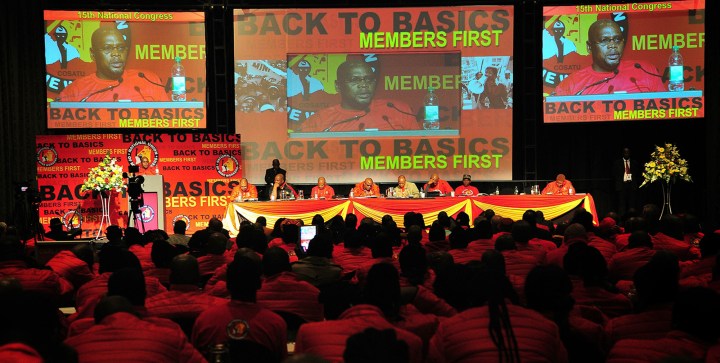LABOUR PAINS
Despite gains, the NUM faces an existential crisis at 40

The once mighty union has many uphill battles ahead to remain relevant in a shrinking sector.
The National Union of Mineworkers (NUM) turned 40 this month, and finds itself facing a midlife crisis. Does it retain its political alliance with the ANC? Will it continue to work with its former archrival, the Association of Mineworkers and Construction Union (Amcu), in wage negotiations? And can it grow its membership as the mining sector declines?
But 40 can also be a time to reassess one’s past to help chart a path for the future. One way to look at the NUM now is to compare the lives of black mine workers today with their lot in the 1980s, when South Africa’s political economy was still defined by apartheid. The contrast is jarring — in a good way — and the NUM surely deserves a lot of credit for that.
In 1984, the earliest year for which DM168 could find reliable data, 800 South African mine workers were killed in accidents on the job. As of late November, the death toll in 2022 stood at 44 and in 2019 there was a record low of 51 accidental deaths in South Africa’s mines. To be sure, it was almost one a week on average, but a far cry from the carnage that prevailed under apartheid.
There have also been vast improvements on the health front, with a dramatic reduction in silicosis and other occupational diseases linked directly to mining.
The undignified hostel system is a thing of the past, and black mine workers no longer earn the wages that kept them in poverty over the course of the 20th century.
Far from it. Minerals Council data on the annual remuneration paid to South African mine workers show it rose each year on average by 9.4% from 2001 to 2020, according to DM168 calculations. South African consumer inflation averaged about 5.5% a year over that period, calculations made from Stats SA’s historical data show.
The upshot is that wage growth in the mining sector was almost double the rate of inflation between 2001 and 2020. In 2001, the average earnings per employee per year stood at R59,874. By 2020, that had reached R335,096, a five-and-a-half-fold increase.
All these improving trends — safety, health, housing conditions and wages — are rooted in a range of factors. The end of apartheid was clearly one, and the NUM played an activist role on that front by confronting head-on the economic backbone of white-minority rule.
Its founding leader, Cyril Ramaphosa, would trade in his union hat for an ANC one and lead the negotiations on behalf of the ANC that resulted in South Africa’s negotiated political settlement, consigning the apartheid regime to the dustbin of history.
“If one group treats another group as inferior, which is what apartheid is about, then you can imagine that some people would not have cared enough for black lives,” said Rohitesh Dhawan, the South African CEO of the London-based International Council on Mining and Metals.
The improvement in mining lives and livelihoods is also a reflection of the rise of environmental, social and governance issues that have become embedded in corporate culture in response to regulatory, investor and public demands and scrutiny.
Visit Daily Maverick’s home page for more news, analysis and investigations
Mines hit by legal action
Legal action also hit mines, with the cost of “legacy issues” thrown into sharp relief by the R5-billion class-action silicosis settlement in 2018, which compensated gold-mine workers who had contracted the incurable lung disease underground.
But organised labour has clearly played a role as well. For about three decades, the NUM was by far the biggest union home for black mine workers as their conditions of employment steadily improved, bearing testimony to the union’s activism.
Yet, by 2012, as the union approached its 30th anniversary, the NUM was being undermined by its own success, and a sense of complacency had set in. This came amid a growing perception among the rank and file that the union was perhaps becoming too accommodating to capital and distracted by its commitment to the ruling ANC at a time when corruption, State Capture and governance failure were becoming endemic under Jacob Zuma’s disastrous administration.
And one of the key measures the NUM had long been pushing for — the end of the exploitative migrant labour system — largely remained in place.
Stage set for uprising
This set the stage for an uprising on the Platinum Belt by rock-drill operators hailing mostly from the old Transkei. They were led by the charismatic Joseph Mathunjwa, Amcu’s president, who could work a crowd with a message that mixed Christian salvation and African nationalism with a strident anti-capitalist tone. Pointedly, Amcu was a breakaway union from the NUM.
The ensuing turf war between the NUM and Amcu claimed scores of lives and unleashed waves of labour unrest. Most infamous and deadly was the wildcat strike at Lonmin’s Marikana mine in August 2012 that culminated in the police shooting dead 34 striking mine workers.
By that time, the NUM’s founder, Ramaphosa, was a director at Lonmin and deputy president of the ANC, and in an email had called for “concomitant action” to deal with the strike.
A decade later, Marikana’s legacy includes a drive to mechanisation where South Africa’s difficult geology allows, and a sharp decline in the use of migrant labour. Mine workers, NUM members included, are much better paid than they were a decade ago and work in safer and healthier conditions.
But there are fewer of them.
In 2012, South Africa’s mines employed almost 525,000 workers, according to Minerals Council data. In 2021, that number stood at just shy of 459,000.
The NUM a few years ago had more than 300,000 members, but its membership is closer to half that now.
A shrinking pool of potential members and the demise of the migrant labour system are among the factors that probably explain why the NUM and Amcu have buried their once-lethal enmity.
The two unions have united in wage talks and while they joined forces to strike at Sibanye-Stillwater’s gold mines in 2021, their partnership has also yielded a spate of five-year deals in the platinum sector that were achieved without a tool being downed.
Daily Maverick was unable to reach the NUM’s general secretary, William Mabapa, for an interview before going to press, but he is an earthy mine worker who worked his way up the ranks and seems generally committed to bread-and-butter union issues.
The union is delighted with André de Ruyter’s departure from Eskom and remains opposed to any privatisation of the ailing state-owned enterprise and its unbundling into three units.
It’s hard to imagine Mabapa following in Ramaphosa’s footsteps, amassing a fortune in the world of business and stashing US dollars in his furniture. But he and another former NUM leader, Minerals and Energy Minister Gwede Mantashe, are in broad agreement about protecting the coal industry and the jobs that go with it.
That will certainly be among the NUM’s priorities in the coming years. Time will tell if this presents an obstacle to South Africa’s energy transition. DM168
This story first appeared in our weekly Daily Maverick 168 newspaper, which is available countrywide for R25.














 Become an Insider
Become an Insider
No mention of the corruption in the NUM? They skim from every contract – is this news?